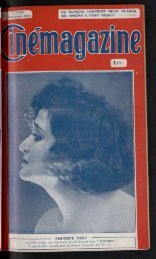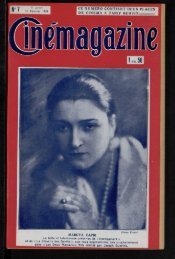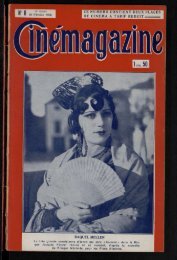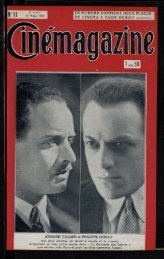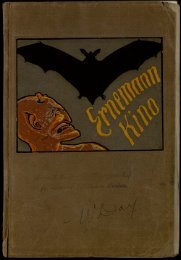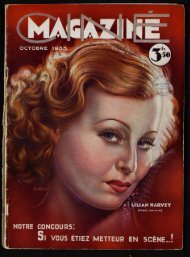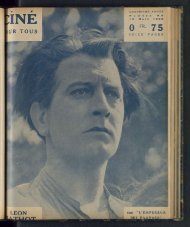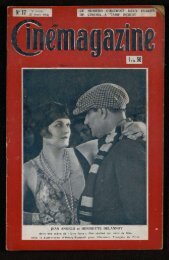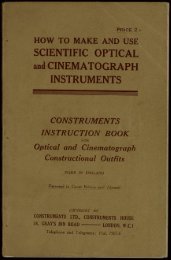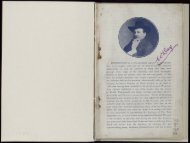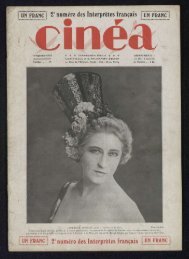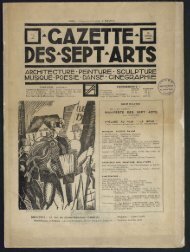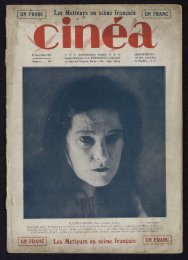Untitled
Untitled
Untitled
You also want an ePaper? Increase the reach of your titles
YUMPU automatically turns print PDFs into web optimized ePapers that Google loves.
46 MODERN MAGIC LANTERNS.<br />
Fig. 35, by the screw s. The holder shown in Fig. 35<br />
should be secured by screws to a board cut to slide in<br />
the grooves in the lantern, so as to be readily centered. In<br />
Fig. 34 (a diagram of the connections for the incandescent<br />
lamp), the variable resistance, B, can<br />
be dispensed with if the lamp is only<br />
to be run at its normal brilliancy, in<br />
favour of a fixed resistance, or if the<br />
current is supplied at the pressure required<br />
by the lamp the resistance can<br />
be done away with altogether. The<br />
connections with the mains are shown<br />
at c c.<br />
The arc lamp is, however, the form<br />
of electric light which seems peculiarly<br />
adapted for projection purposes,<br />
Fig. 35. HOLDER FOR<br />
INCANDESCENT LAMP.<br />
since it fulfils two important conditions,<br />
a most intense light with the smallest<br />
possible area. The arc lamp is so<br />
called because the light is caused by the<br />
current passing across an air space or arc between two carbon<br />
points, which are, by it, heated to a great brilliancy. The arc<br />
has first to be "struck," that is, the carbons must touch each<br />
other when the current is first switched on, and have then to<br />
be separated to the required distance to form the arc. As<br />
the light is emitted the carbons gradually burn away, the<br />
positive at about twice the rate of the negative ; means<br />
have, in consequence, to be provided to keep their ends, or<br />
poles, at an uniform distance apart, so that the arc may be<br />
maintained.<br />
Arc lamps may be divided into two classes, according to the<br />
way this uniform distance is maintainedautomatic when<br />
the current itself actuates or regulates the "feed " of the<br />
carbons, and "hand fed" when this is done by the<br />
operator. Both kinds are made in a convenient form for the<br />
lantern, but as hand-fed lamps do not require much attention<br />
from the lanternist, who is, moreover, on the spot to<br />
give them that little, and as they are much cheaper and less<br />
likely to get out of order, they are to be preferred. Fig.<br />
36 is a simple type of automatic lamp, the "Scissors," by<br />
THE ELECTRIC LIGHT.<br />
Borland, of Leeds, it is also made for hand feed ; several<br />
other patterns are on the market which space precludes us<br />
from describing. Of hand-fed lamps, Davenport's, made by<br />
Messrs. Steward and Co., though in the writer's hands for<br />
but a short time, has so far proved satisfactory. It is shown<br />
)h 111111111111111111111101111111111<br />
11111111111111111\1111111111111%m,<br />
_<br />
'LA "II 141.0Ls. LEEDS.<br />
Fig. 36. THE "SCISSORS" AUTOMATIC ARC LAMP.<br />
in Fig. 7. The upper is the positive carbon, which is<br />
gradually fed down by the rod and handle seen projecting<br />
at the back, the lower or negative carbon being pushed up by<br />
a spring against two screws, which prevent it going too far.<br />
To get the best light the end of the negative carbon should<br />
be a little nearer the condenser than the other, and the<br />
arc should not be too long. If too long, a flame will be<br />
seen to play round it ; if too short, it will probably "sing."<br />
When the carbons have burned for a little time it will be<br />
seen that while the negative has come to a rounded point<br />
in shape, the positive has a little bowl or crater at its end,<br />
and it is from the inside of this crater that the most intense<br />
light is emitted: It is for this reason that the arc lamp for<br />
47



